In the realm of project management, a Work Breakdown Structure (WBS) stands as a cornerstone, providing a systematic approach to dissecting and organizing complex projects into manageable components. As a visual representation of the project's scope, WBS aids in better planning, communication, and execution. In this article, we will explore the intricacies of WBS, its significance, and the steps involved in creating an effective breakdown.
Part 1. What is the Work Breakdown Structure?
A Work Breakdown Structure (WBS) is a hierarchical decomposition of a project into smaller, more manageable components or work packages. It is a visual and organized way to break down a project into its fundamental elements, allowing for easier planning, management, and control.
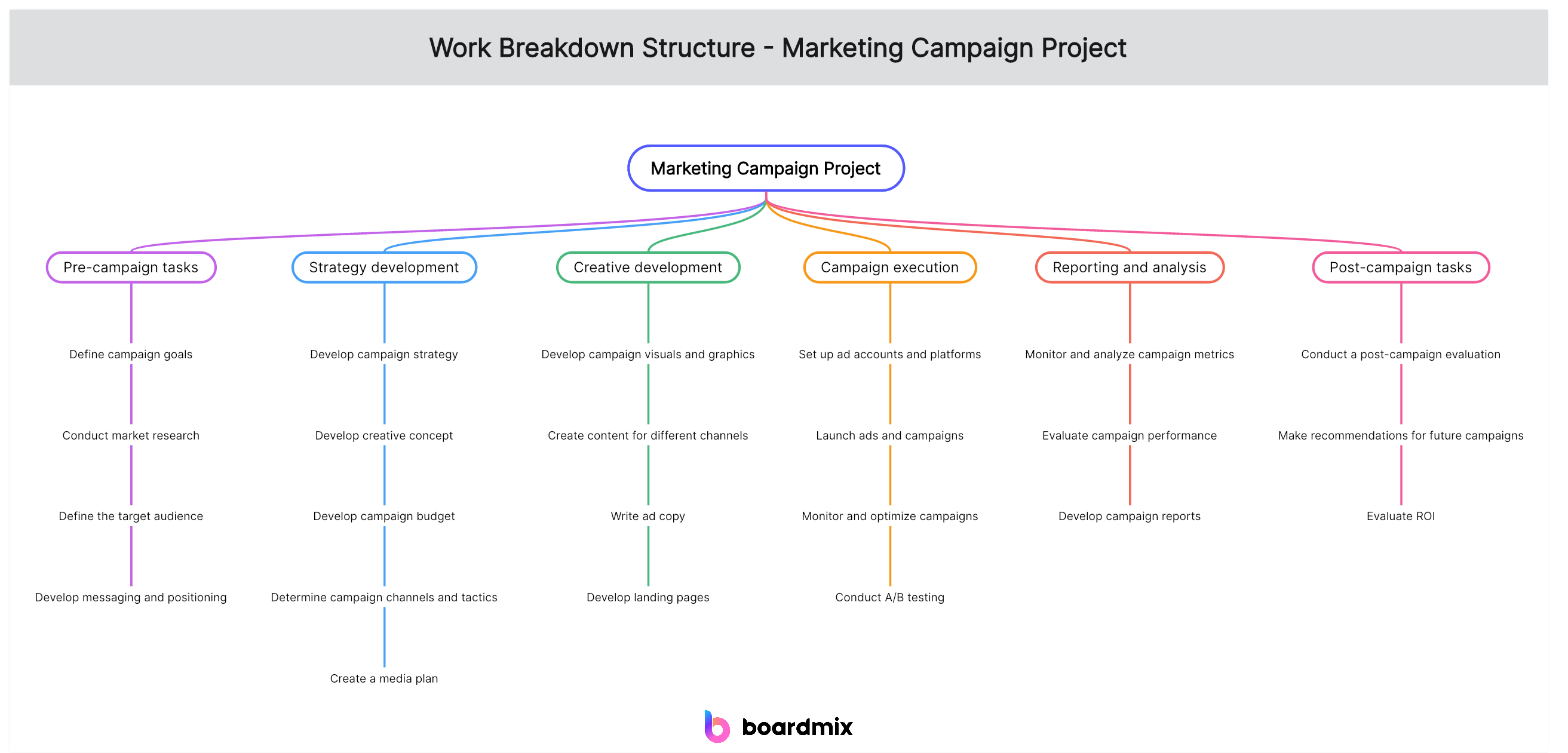
The WBS starts with the overall project at the top level and then breaks it down into progressively smaller and more detailed components. Each level of the hierarchy represents a more detailed level of work until you reach the lowest level, which consists of individual tasks or activities that can be easily managed and monitored.
Part 2. What are the Key Components of Work Breakdown Structure?
The Work Breakdown Structure (WBS) comprises several key components that help organize and break down a project into manageable parts. These components include:
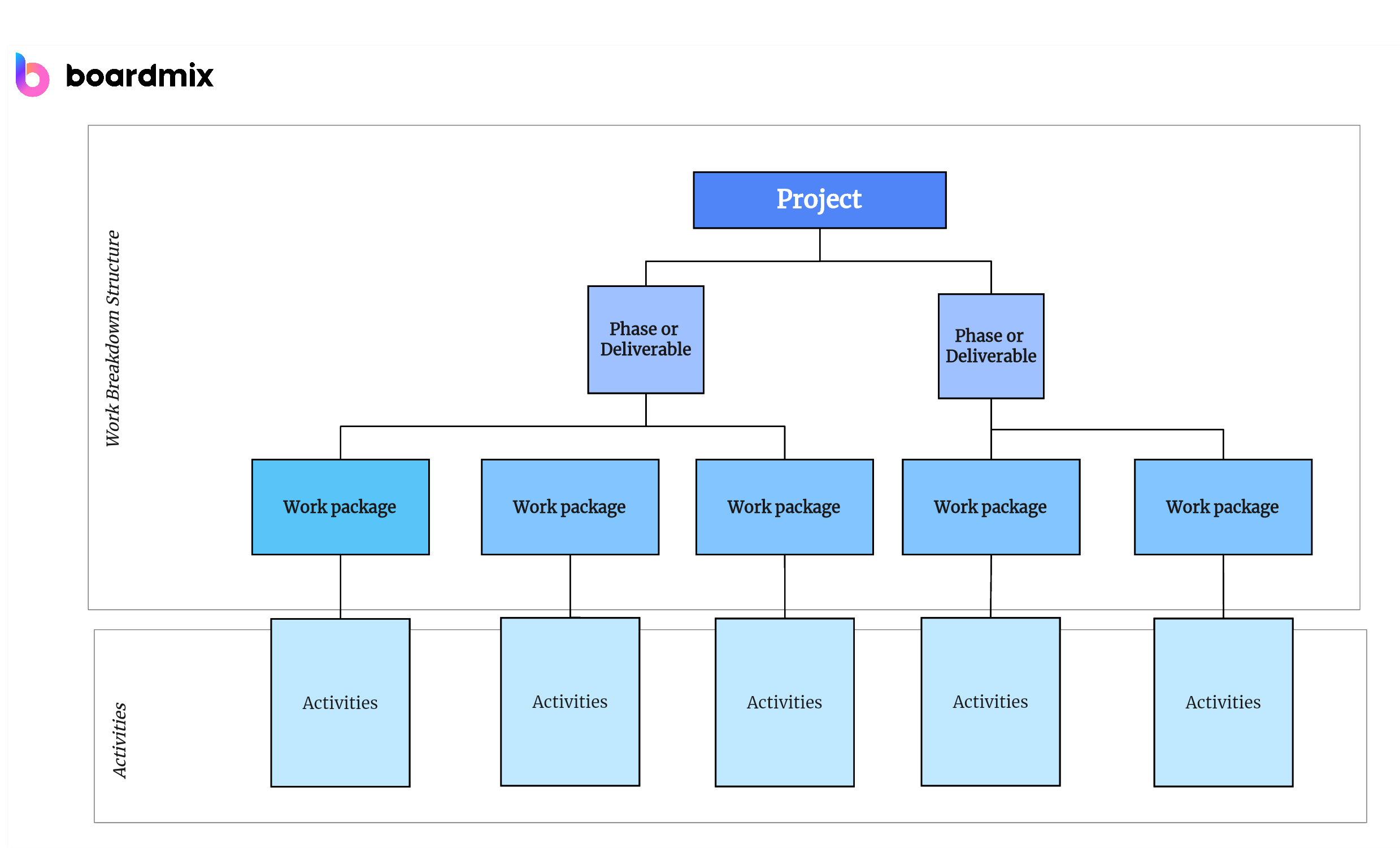
Phases:
The highest level of WBS, phases represent major stages in the project. These are the broad categories under which all project activities are grouped. Phases often align with the project's timeline and major milestones.
Deliverables:
Within each phase, deliverables represent tangible outcomes or results. These are the products or services the project aims to produce. Clearly defining deliverables helps in understanding project objectives and ensures that all stakeholders share a common vision.
Work Packages:
Work packages are the smallest units in the WBS hierarchy. They are specific tasks or activities required to complete a deliverable. Work packages are defined to a level where they can be easily assigned to a team member, and progress can be measured.
Part 3. What Are the Purposes of Work Breakdown Structure?
The Work Breakdown Structure (WBS) serves several important purposes in the field of project management. These purposes contribute to better project planning, execution, and control. Here are the key purposes of a Work Breakdown Structure:
- Project Planning: The WBS helps in systematically breaking down the overall project into smaller, more manageable components. This facilitates the planning process by providing a structured framework to identify tasks, activities, and deliverables.
- Scope Definition: It helps in defining and clarifying the scope of the project. By breaking the project into smaller elements, the WBS ensures that all necessary work is identified and included in the project scope.
- Resource Allocation: The WBS provides a basis for resource allocation. By identifying the specific tasks and work packages, project managers can allocate resources more effectively and ensure that each element of the project has the necessary resources.
- Communication: It serves as a visual and organized tool for communicating project structure and components to all stakeholders. The WBS helps in conveying a clear understanding of the project to team members, management, clients, and other relevant parties.
- Project Tracking and Control: The WBS is instrumental in tracking project progress and controlling its scope. Each level of the hierarchy in the WBS can be used as a reference point for monitoring and controlling the project. It also helps in identifying any changes in scope and managing those changes effectively.
In summary, the Work Breakdown Structure is a fundamental tool in project management that supports various aspects of project planning, execution, and control, ultimately contributing to the successful completion of projects.
Part 4. What Are the Benefits of Work Breakdown Structure?
The Work Breakdown Structure (WBS) offers several benefits in the field of project management. These advantages contribute to improved project planning, communication, execution, and control. Here are some key benefits of using a WBS:
Clarity and Understanding: WBS provides a visual representation of the project, making it easier for stakeholders to understand the project's structure and scope. This clarity fosters effective communication and collaboration among team members.
Resource Allocation: By breaking down the project into smaller components, WBS allows for a more accurate allocation of resources. This ensures that each task is adequately staffed, preventing bottlenecks and optimizing efficiency.
Risk Management: WBS aids in identifying potential risks by highlighting critical paths and dependencies. Understanding the interrelation of tasks and deliverables enables proactive risk management, minimizing the impact of unforeseen challenges.
Supports Project Team Collaboration: The WBS promotes collaboration within the project team by breaking down the project into manageable parts. Team members can clearly see their responsibilities and understand how their work contributes to the overall project objectives.
The Work Breakdown Structure is a powerful tool that brings numerous benefits to project management, improving planning, communication, and overall project success.
Part 5. How to Make a Work Breakdown Structure
Creating a Work Breakdown Structure (WBS) involves a systematic process of breaking down a project into smaller, more manageable components. Here's a step-by-step guide on how to make a WBS:
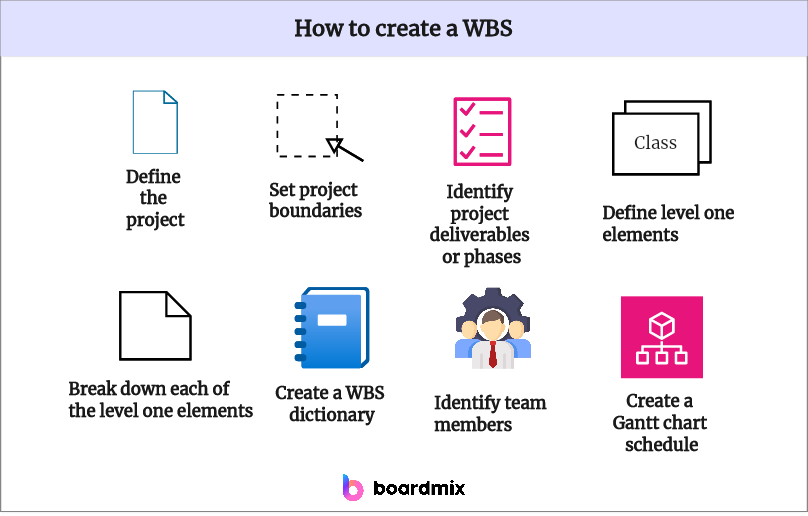
Step 1. Define Project Objectives: Clearly articulate the project's overall goals and objectives. This sets the foundation for creating a WBS that aligns with the project's purpose.
Step 2. Identify Phases: Divide the project into major phases. These should represent distinct stages in the project's lifecycle, such as planning, execution, and closure.
Step 3. Break Down Deliverables: For each phase, identify and list the deliverables. These should be specific, measurable, and directly contribute to achieving the project's objectives.
Step 4. Develop Work Packages: Break down each deliverable into smaller, manageable work packages. These should be detailed enough for assignment and tracking.
Step 5. Create Hierarchy: Organize the components in a hierarchical structure, with phases at the top, followed by deliverables, and finally, work packages. This visually represents the project's structure and dependencies.
Part 6. Boardmix – Create Work Breakdown Structure Easily
Boardmix is a cutting-edge online whiteboard tool that simplifies the process of creating a work breakdown structure (WBS). With our extensive range of drawing templates, you can easily visualize your project's hierarchy and break down your work into manageable sections. This not only aids in understanding the scope of your project but also helps in assigning tasks, estimating costs, and managing timelines more effectively. Unlike other tools like Miro or Figjam, Boardmix offers an intuitive interface that makes it easy for teams to collaborate in real-time, regardless of their location. Start using Boardmix today to streamline your project management process and enhance productivity.

Real-time Collaboration: Boardmix allows multiple users to work together on a project simultaneously, regardless of their geographical location.
Extensive Drawing Templates: With a wide variety of templates, Boardmix makes it easy to visualize complex ideas and processes.
Intuitive Interface: Boardmix's user-friendly design ensures that even those with minimal technical skills can navigate and use the tool effectively.
Project Management Features: From creating a work breakdown structure to assigning tasks, Boardmix provides all the necessary tools for efficient project management.
Cross-Platform Accessibility: Whether you're using a PC, tablet or smartphone, Boardmix is accessible across all devices for seamless collaboration.
How to Create Work Breakdown Structure with Boardmix
1. Log in to your Boardmix account: If you don't have one, sign up for free and create your account.

2. Choose a Template: Navigate to our extensive library of templates and select the one that best suits your project's needs.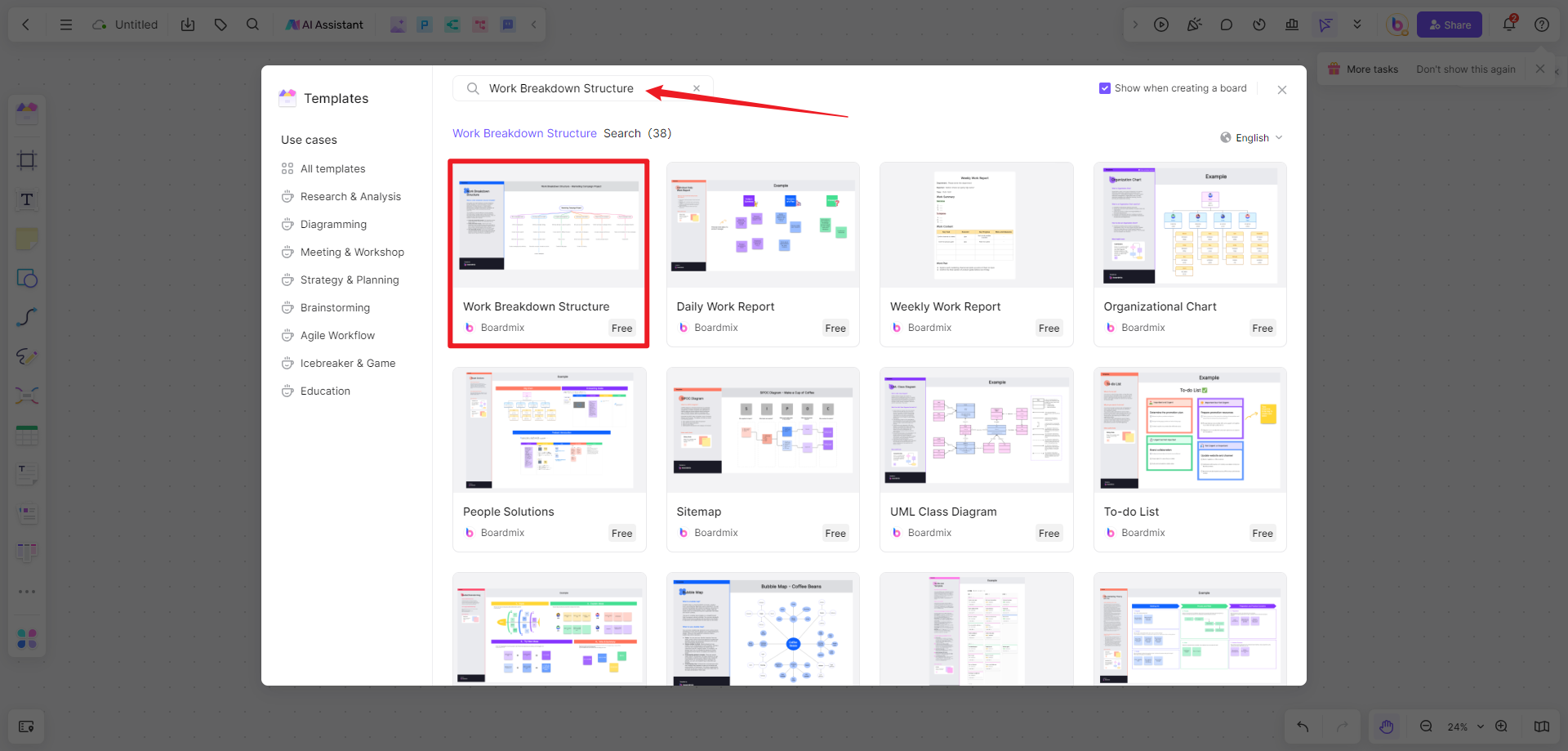
3. Add Tasks: Start breaking down your project into smaller, manageable tasks. You can add as many tasks as needed.
4. Assign Tasks: Once you've broken down the project, assign each task to team members directly within Boardmix.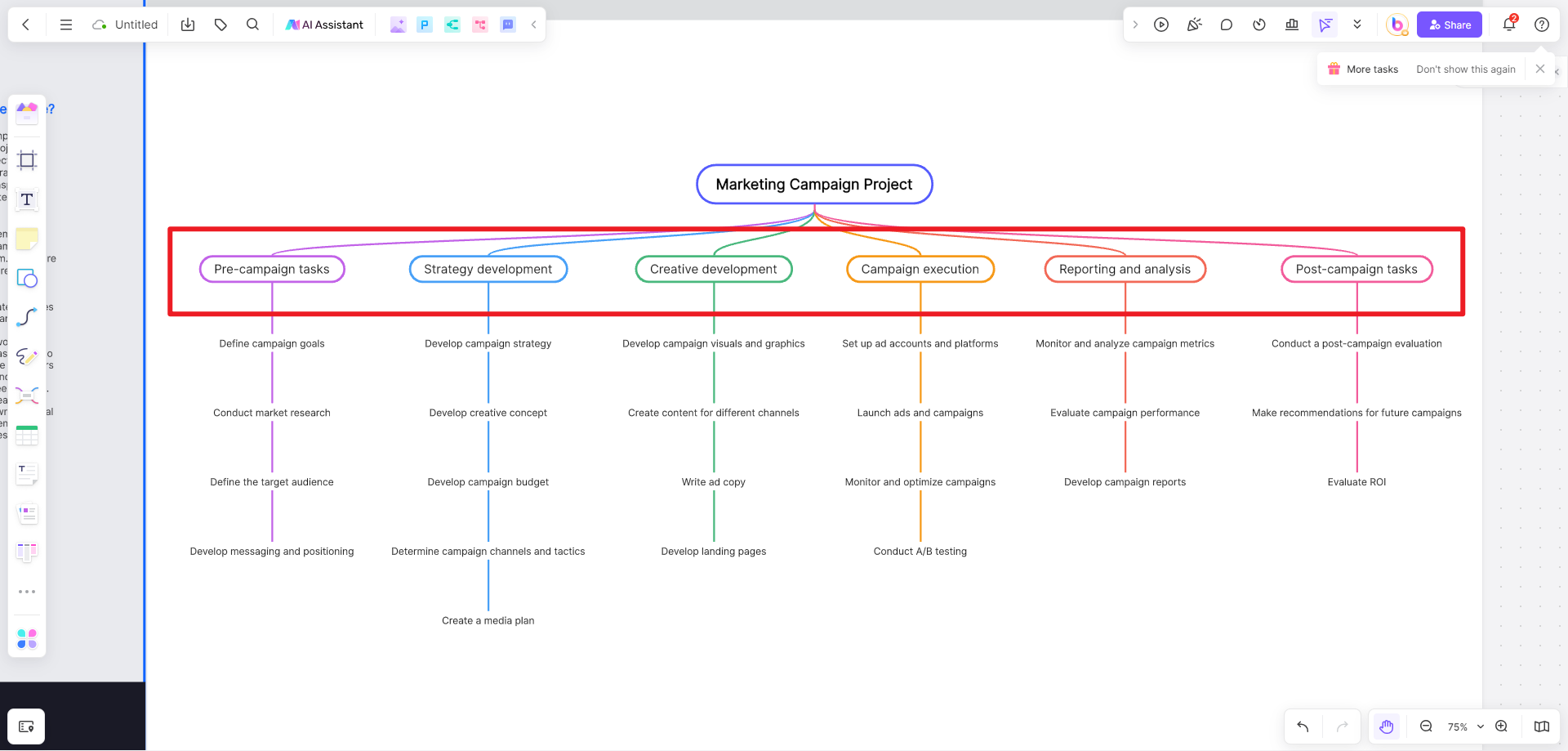
5. Collaborate in Real-Time: Invite your team members to join the board and start collaborating in real-time.
6. Monitor Progress: Use Boardmix's intuitive interface to track progress and make adjustments as necessary.
FAQs about Work Breakdown Structure
1. What are the 3 levels of work breakdown structure?
The Work Breakdown Structure (WBS) consists of three levels. Level 1 represents the overarching project or phase, offering a broad perspective. Level 2 breaks down major components from Level 1 into detailed sub-phases or major deliverables. Finally, Level 3 delves into specific work packages or tasks, providing the most granular level of decomposition. This hierarchical structure aids in project planning, resource allocation, and tracking, fostering effective communication and control throughout the project lifecycle.
2. What WBS means?
WBS stands for "Work Breakdown Structure." It is a hierarchical decomposition of a project into smaller, more manageable components or work packages. The WBS helps in organizing and breaking down the project's scope into distinct elements, facilitating project planning, execution, and control.
3. What is the 8 80 rule in WBS?
The 8/80 rule in Work Breakdown Structure (WBS) refers to a general guideline for defining work packages. According to this rule, a work package should not be too small (less than 8 hours of work) or too large (more than 80 hours of work). The idea is to find a balance that allows for effective project management.
Conclusion
In conclusion, a well-constructed Work Breakdown Structure is an invaluable tool for project managers seeking to navigate the complexities of project management. By providing a systematic breakdown of tasks, deliverables, and phases, WBS enhances communication, facilitates resource allocation, and promotes effective project execution. Embracing the principles of WBS empowers project teams to tackle challenges with precision and ensures successful project outcomes.
Experience the future of project management with Boardmix, your ultimate tool for creating effective work breakdown structures. With our real-time collaboration feature and extensive drawing templates, you can easily break down complex projects into manageable tasks and collaborate with your team seamlessly. Don't just take our word for it, sign up for a free trial today and discover how Boardmix can revolutionize your project management process.













